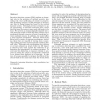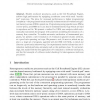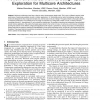17 search results - page 2 / 4 » The KILL Rule for Multicore |
ACSW
2006
13 years 6 months ago
2006
Intrusion detection systems (IDS) perform an important role in the provision of network security, providing real- time notification of attacks in progress. One promising category ...
GPEM
2006
13 years 5 months ago
2006
Abstract. Too much information kills information. This common statement applies to huge databases, where state of the art search engines may retrieve hundreds of very similar docum...
TACAS
2010
Springer
14 years 6 days ago
2010
Springer
Modern multicore processors, such as the Cell Broadband Engine, achieve high performance by equipping accelerator cores with small “scratchpad” memories. The price for increase...
TPDS
2008
13 years 5 months ago
2008
Multicore architectures have been ruling the recent microprocessor design trend. This is due to different reasons: better performance, thread-level parallelism bounds in modern app...
POPL
2007
ACM
14 years 5 months ago
2007
ACM
Constraint Handling Rules (CHR) is a concurrent committedchoice constraint logic programming language to describe transformations (rewritings) among multi-sets of constraints (ato...



